California Grown and Visit California are teaming up to produce the #Farm2Fan video series, profiling farms throughout California and fans of those farms who stop by for a visit.

California Grown and Visit California are teaming up to produce the #Farm2Fan video series, profiling farms throughout California and fans of those farms who stop by for a visit.
Internship/mentoring program brings in ag students for summer study in public service
The average age of the California farmer is about 60 – and it’s rising. Here at the California Department of Food and Agriculture, and on California farms, and in organizations throughout our agricultural community, that one, simple fact urges us all to prepare now for a future that is fast approaching. Whether it’s a farm family handing over the reins, or a CDFA office preparing its next generation of leaders, the process is both daunting and rewarding.
One way we help the agricultural community grow the next crop of leaders at CDFA is through a program of internships and mentoring to develop new prospects for public service in the agricultural realm. And even when these folks don’t have immediate plans to work in the government, there’s a real value in acquainting them with our state’s approach to agricultural oversight on their way into the workforce.
CDFA’s Inspection Services Division – they keep tabs on everything from the quality of fruit to the labeling of fertilizers – incorporates internships and mentoring as part of its broader “succession planning” efforts to develop the current and future talent pool for our agency and for the larger agricultural community as well. In 2015, the division inked a partnership with major college programs to bring in students from agricultural education programs as summer interns.
This summer, CDFA brought in two aspiring agricultural leaders, Kristin Fernandez and Hannah Garrett. Kristen, a senior at Cal Poly, San Luis Obispo, is studying Agricultural and Plant Sciences with a concentration in Fruit and Crop Science. This fall, Kristen will begin courses in Entomology, Plant Pathology and Viticulture. Hannah is a recent graduate of California State University, Chico, with a degree in Agricultural Sciences. Hannah will soon begin her career as an intern agriculture teacher with Chico High School.
The pair participated in several field tours to gain hands-on experience with the field work done by CDFA’s inspectors. Field tours included shadowing inspectors, seeing CDFA laboratories, attending board and committee meetings, and seeing facilities such as Sacramento Rendering Company and a Foster Farms feed mill.
Another notable tour arranged by the Division’s Fertilizer Research and Education Program (FREP) (https://www.cdfa.ca.gov/is/ffldrs/frep/) included interns and mentors traveling to Salinas to visit a broccoli field where researchers are collecting data for CropManage. The project, which began as a solely FREP-funded project to provide a scheduling tool for lettuce growers, helps growers schedule irrigation and fertilizer events on a block level basis, as well as archive and manage the information for later reporting requirements.
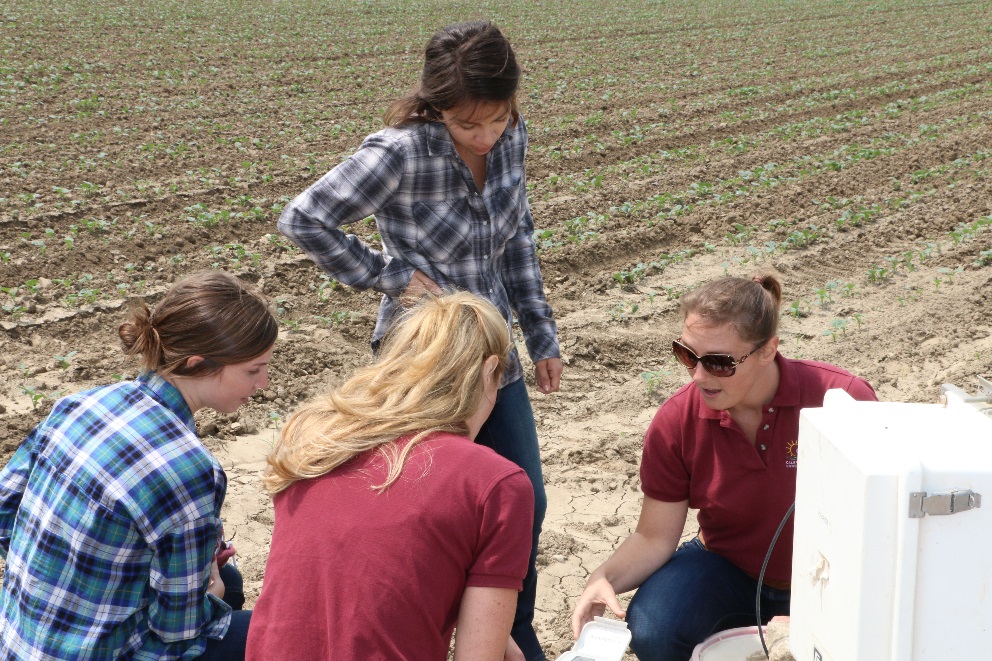
Right to Left: Natalie Jacuzzi with CDFA’s Fertilizer Research and Education Program (FREP); Kristen Fernandez, Intern; Natalie Krout-Greenberg, ISD Director; Hannah Garrett, Intern. For 25 years, the FREP office has invested in pioneering fertilizer research focused on agronomic efficiency in the management of nutrients, precision irrigation and fertigation practices, soil, and crop and fertilizer interactions. FREP’s greatest achievement over the years is the way it makes research available to farmers and advisors who are in a position to put it to good use. In the photo above, Natalie Jacuzzi, with the FREP, explains how CropManage can be a useful tool for on farm nutrient management.
Our Inspection Services Division’s mentorship program works hand-in-hand with the internship program by giving our existing staff applied leadership experiences. Division mentors are involved in the intern selection process, and they coordinate with management to determine the projects those interns will take on. Mentors then provide coordination and assistance to their respective interns throughout the summer.
Through experiences like these, CDFA’s Inspection Services Division’s interns and future agriculture leaders are able to learn about programs and policy initiatives throughout their summer with us. Offering students this opportunity helps create future leaders and also helps students understand and appreciate our dynamic agricultural system.
And who knows? Maybe they’ll be back to run the place someday.
By Sonali Kohli
Most school days 17-year-old Alex Snyder eats lunch with a pot-bellied pig named Peanut.
John R. Wooden High School is small. It doesn’t have a football field or a swimming pool or a gym. But it has a farm. And the farm has become a central part of Alex’s life.
“It’s my job to go around…every morning and feed the animals,” Alex recently told students visiting the grounds during his first-period animal behavior class as he took them by a pair of tussling goats, past the shed filled with hay for the two alpacas, toward the pigs who were lying by the small pond.
Alex, who lives in a foster care group home, used to run away for days at a time to visit his girlfriend. He’d ditch school at Grover Cleveland Charter High in Reseda and go to the library instead.
Since transferring to Wooden this year, he’s been at school most mornings.
“It’s good for me,” Alex said. “If this is my first period, it kind of makes me want to come to school every day.”
Wooden is a continuation school, mostly for students who are behind in credits and at risk of not graduating. As schools in L.A. Unified increasingly turn to online credit recoveryclasses to allow more students to graduate on time, the staff at Wooden uses the farm for hands-on, face-to-face learning.
Instead of chemistry and biology, students can take environmental studies or plant and soil science, in which they develop a plan for a drought-resistant garden.
Wooden’s operating philosophy — that students can thrive if they get personalized attention and learn concepts through doing — is one that state education officials increasingly are espousing.
California is among a number of states that recently adopted Next Generation Science Standards, which focus on forging connections between classes and integrating scientific investigation into lessons, instead of just having students memorize concepts.
Along those lines, science teacher Stephanie Darling’s first-period class doesn’t take place in a classroom with her standing in front of a whiteboard. Usually, she does not even lead lessons. Students learn them by her side at the farm.
On one September morning, some of her students were tending to the animals — feeding the chickens, cleaning water bowls — while others were watering plants or working in the organic garden.
All of the animals were rescued. A few years ago, with the help of the nonprofit Kindred Spirits Care Farm, the school planted the garden. Now tomato plants wind around arches, offering shade to the basil plants below.
Bryant Santoyo’s first-period task was to shovel mulch into the garden.
At first, he couldn’t explain why he was shoveling.
But Darling pushed him, asking: What is this for?
They’re going to grow blueberry plants, he told her.
What will the mulch do?
Cover the ground to keep it cool and act as fertilizer, he answered, correctly.
Bryant, 17, enrolled at Wooden after dropping out of a few other schools. To keep his job at Ralphs, he needed to prove he was in school.
He’s liking school now, he said, and the way Wooden gets him to learn new things.
“We see the process of something growing,” Bryant said.
One goal of the new science standards is to attract students in populations underrepresented in science, technology, engineering and math careers, and prepare them for those fields, said Derrick Chau, senior executive director for instruction at L.A. Unified.
Estephanie Aparicio, 16, wants to be a veterinarian. She fell behind at her former school, Reseda High, after she was bullied and suffered from panic attacks and depression.
At Wooden, she’s not only learned the basics of caring for animals, but has found that spending time with them has been therapeutic.
“My anxiety has basically gone away,” she said. Her favorite animal is Evan, a white alpaca.
On Oct. 22 the school will invite the public to Food Day LA to learn about the farm, garden and how to bring urban agriculture to their backyards.
One concern about continuation schools is whether they’re rigorous enough to prepare students for college.
Darling is Wooden’s only science teacher. She teaches animal behavior, plant and soil science and environmental studies. Animal behavior is an elective, but students who enroll in the other classes use those as science requirements for Cal State University admission, Darling said. As for the University of California, only plant and soil science counts toward science entrance requirements.
Students interested in attending UC schools can take extra science classes after school or complete different assignments in one of Darling’s existing classes.
Alex takes an integrated-coordinated science class with students in Darling’s environmental studies class to get credit for the specialized instruction if he applies to UC.
His hope is to graduate in 2017, attend a community college for two years and transfer to a four-year school to become a nurse.
He hasn’t ditched school in weeks and doesn’t plan to, he said while petting Peanut.
“It’s peaceful, and I like the animals,” he said. “They’re better company than people.”
The second annual Growing Together Latino Farmer Conference will be held Tuesday, Nov. 15, 2016, in Monterey, California. This annual conference is unique in that it is conducted in Spanish and translated into English for all attendees.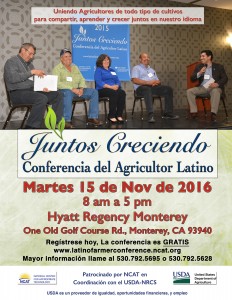
“Hispanic farmers and ranchers are a dynamic growing demographic in California and this conference aims to help Spanish-speaking farmers share, learn and grow in their native language,” said Carlos Suarez, NRCS state conservationist.
To see a video recap of last year’s conference, please visit here.
Hosted by the National Center for Appropriate Technology (NCAT) and the U.S. Department of Agriculture (USDA), the conference is open to all farmers and ranchers, yet is uniquely tailored towards Spanish-speaking growers. The program will be translated into English, with translation headsets. Conducting the conference in Spanish will provide an enriched learning experience.
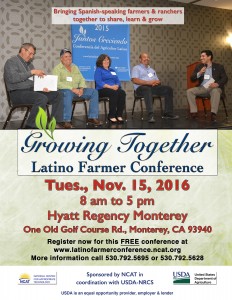 The conference will be held from 8 a.m. to 5 p.m. at the Hyatt Regency Monterey, located at 1 Old Golf Course Rd, Monterey, California, 93940. The conference is free to all attendees and will include breakfast, lunch and light appetizers. Please contact Victor Hernandez at (530) 792-5628 or Thea Rittenhouse (530) 792-7338 with any questions pertaining to the conference.
The conference will be held from 8 a.m. to 5 p.m. at the Hyatt Regency Monterey, located at 1 Old Golf Course Rd, Monterey, California, 93940. The conference is free to all attendees and will include breakfast, lunch and light appetizers. Please contact Victor Hernandez at (530) 792-5628 or Thea Rittenhouse (530) 792-7338 with any questions pertaining to the conference.
Three different workshops will follow an opening keynote address by Javier Zamora, an organic farmer and leading conservation steward and educator. The courses will be held in two 90-minute blocks. This allows each attendee to choose two different subjects of interest throughout the day. The workshops topics will cover: Access to Capital and USDA Resources; Soil Health; Efficient Use of Water; Bee Keeping and Marketing. The conference will conclude with a farmer panel representing a diverse cross section of California agriculture.
Attendees must register in advance, as space is limited. Please visit https://latinofarmerconference.ncat.org/register.php to register.
On January 4, 2011, President Obama signed landmark legislation – the Food Safety Modernization Act (FSMA), the most sweeping reform for food safety laws in over 70 years. FSMA aims to create an integrated food safety system and improve the quality of food products to the public by reducing foodborne illness. Implementation of FSMA for the Produce Safety Rule will begin January 2018.

CDFA Secretary Karen Ross, Dr. Stephen Ostroff, FDA Deputy Commissioner for Foods and Veterinary Medicine, and stakeholders participate in round table discussion.
The California Department of Food and Agriculture’s (CDFA) Division of Inspection Services hosted a three-day produce industry tour earlier this month for officials from the U.S. Food and Drug Administration (FDA) to learn about California’s diverse farming operations, and to meet with producers. The tour brought together a team from the FDA led by Dr. Stephen Ostroff, Deputy Commissioner for Foods and Veterinary Medicine, and also included CDFA Secretary Karen Ross, state partners from the California Department of Public Health, and industry representatives.
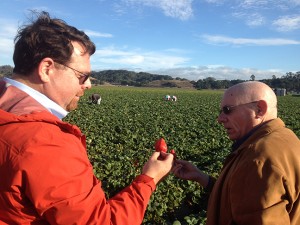
California Strawberry Commission President Rick Tomlinson and Dr. Stephen Ostroff, FDA Deputy Commissioner for Foods and Veterinary Medicine.
The activities kicked-off in Fresno, beginning with a tour of a stone fruit and table grape operation, a citrus orchard and packing house, and an almond processing operation. That same day, tour participants joined a round table discussion that included a presentation by the California Farm Bureau Federation and focused on California’s water systems and infrastructure. In light of the state’s continued drought, water use efficiency is critical and farmers are focused on using every last drop in the most effective manner. The water round table provided FDA officials first-hand information on California’s complex water system and the many challenges faced by agricultural producers and the impacts as a result of FSMA.

CDFA Secretary Karen Ross, Dr. Stephen Ostroff, FDA Deputy Commissioner for Foods and Veterinary Medicine, and Leafy Greens Marketing Agreement CEO Scott Horsfall.
The second day of the tour was spent in the Salinas Valley visiting a leafy green growing operation and observing a mock food safety audit. After observing harvesting in the field, the tour continued to a processing facility, and then to a strawberry grower. The Salinas Valley tour brought together many stakeholders and provided for a robust round table conversation about food safety, the importance of maintaining an ongoing dialogue with our FDA colleagues, and sharing best practices currently being implemented by farmers.
The tour concluded in San Francisco with a visit to the Golden Gate Produce Market, a wholesale market offering a variety of produce grown throughout California as well as other regions of the world. The market provides a wide array of produce to retailers, foodservice professionals and the public.
The CDFA’s California Produce Industry tour provided FDA officials a small glimpse into California’s diverse and complex farming operations and gleaned first-hand information about the challenges and opportunities for California producers in light of FSMA reforms.
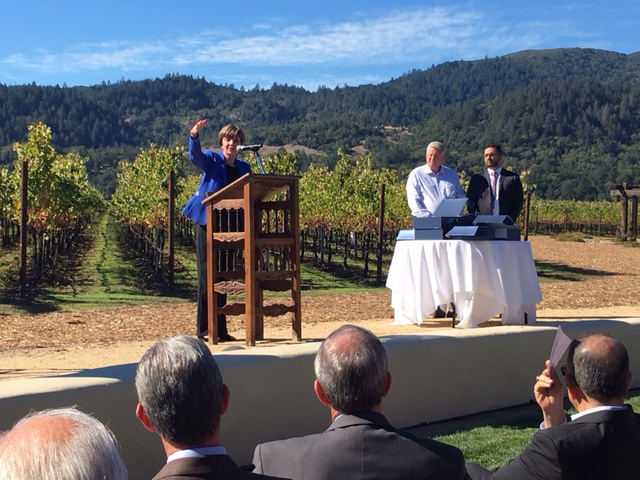
CDFA Secretary Karen Ross speaking at the EGVM eradication event at Robert Mondavi Winery. To her left are Keith Horn with Constellation Wines US and USDA Deputy Under Secretary Elvis Cordova.
CDFA Secretary Karen Ross gathered with grape growers, winemakers, stakeholders and colleagues from federal and county agencies on Friday, Oct. 21 to mark a mutual achievement: eradication of the European grapevine moth (EGVM).
“The growers and their communities where this pest carved out its foothold deserve the lion’s share of the credit for eradicating the European grapevine moth,” Secretary Ross observed. “They formed and sustained the cooperative effort with our agencies that ultimately achieved this goal. We are gathering to celebrate this mutual achievement, but perhaps more importantly we are here to say how proud we are of the partnership that got us here – a partnership that remains ready to respond to the next threat to venture into our vineyards.”
Secretary Ross and others acknowledged the groundwork laid by other cooperative efforts, particularly the exemplary, ongoing work by growers and agricultural officials to control and ultimately find solutions for the grapevine pest the glassy-winged sharpshooter and Pierce’s disease. She commended growers, including the event hosts at Robert Mondavi Winery, for their sustained support in making these projects successful.
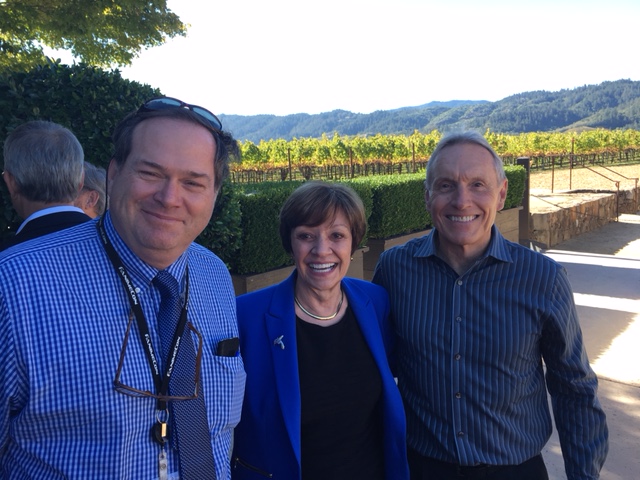
CDFA Secretary Karen Ross congratulates Bob Wynn, Senior Advisor and Statewide Coordinator of the Pierce’s Disease Control Program (right), and John Hooper with CDFA’s Pest Detection/Emergency Projects office (left).
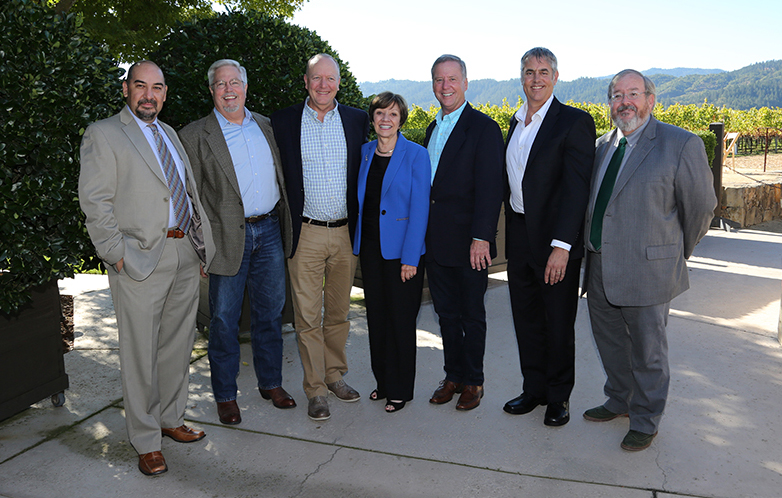
CDFA Secretary Karen Ross (center) with current and former County Agricultural Commissioners whose work was vital to the eradication effort. From left: Humberto Izquierdo (Alameda), Dave Whitmer (Napa, retired), Eric Lauritzen (Monterey), Greg Clark (Napa), Tony Linegar (Sonoma), and Jim Allan (Solano).
California Grown and Visit California are teaming up to produce the #Farm2Fan video series, profiling farms throughout California and fans of those farms who stop by for a visit.
CDFA employees participated this morning in the Great California Shakeout, an annual event urging people to “drop, cover and hold-on” to build awareness about earthquake safety techniques.
CDFA’s Division of Measurement Standards (DMS) is pleased to play a key role in Governor Brown’s 2016 ZEV (Zero Emission Vehicle) Action Plan. ZEV technologies include hydrogen fuel cell electric vehicles (FCEVs) and plug-in electric vehicles (PEVs), which include both pure battery electric vehicles (BEVs) and plug-in hybrid electric vehicles (PHEVs).
The 2016 Action Plan contains six broad goals for the advancement of ZEVs:
Specifically, DMS will support road-scale commercialization of zero-emission fuels to increase access, consumer awareness and confidence in ZEV technologies; maintain infrastructure support through ongoing oversight of the retail fueling businesses serving ZEV owners and operators; help to ensure a network of hydrogen fueling stations to support the commercial launch of fuel cell electric vehicles (FCEVs) and continue to certify the accuracy of hydrogen fuel dispensers. Additionally, DMS will assist the Air Resources Board and the California Energy Commission in the development of standards and protocols, the sharing of standards and best practices, and the building of coalitions collaborate with governments and public-private partnerships in other jurisdictions leading on hydrogen and fuel cell deployment, such as Japan’s Research Association of Hydrogen Supply/Utilization Technology and Germany’s National Organization Hydrogen and Fuel Cell Technology.
Today, California is one of the world’s largest markets for light-duty ZEVs. Californians drive nearly 50% of all the ZEVs in the U.S. and the U.S. comprises about one-third of the world ZEV market. California also leads the U.S. in number of ZEV fueling outlets, with nearly 3,500 PEV charging stations and 11,000 outlets, and 26 hydrogen stations for public use. To date, DMS has been the only U.S. weights and measures jurisdiction to test hydrogen for dispenser accuracy and fuel purity. California is also the first state to research wide-ranging measurement standards that will be suitable for testing of electric charging stations. For additional information on the DMS ZEV Fuels Program, visit https://www.cdfa.ca.gov/dms/programs/zevfuels/.
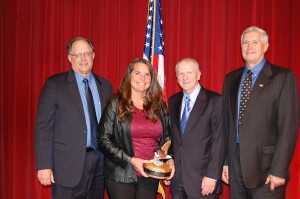
California State Veterinarian Dr. Annette Jones received the USDA APHIS Administrator’s Award this week at the annual meeting of the United States Animal Health Association. Also pictured, from left; Dr. Jere Dick, Associate APHIS administrator; Kevin Shea, APHIS administrator; and Dr. Jack Shere, APHIS deputy administrator.
California State Veterinarian Dr. Annette Jones has been honored for her extensive contributions to animal health and animal agriculture with a 2016 USDA Animal and Plant Health Inspection Service (APHIS) Administrator’s Award, recently bestowed by APHIS administrator Kevin Shea at the annual meeting of the United States Animal Health Association (USAHA).
Dr. Jones, who serves as treasurer of USAHA, was honored for a long list of accomplishments in public service, including directing the state and federal partnership to eradicate an outbreak of exotic Newcastle disease; successfully directing the response to detections of avian influenza; and consistently demonstrating an ability to work cooperatively with other government agencies, the public, and industry in emergency animal disease planning efforts at the local, state, and federal levels.
“This is a very prestigious award at USDA, and no one is more deserving than Dr. Jones,” said CDFA Secretary Karen Ross. “Dr. Jones is a dedicated public servant and an outstanding leader on the many complex issues affecting California’s farmers and ranchers.”
Dr, Jones began her career at CDFA in 2001, was named director of the agency’s Division of Animal Health and Food Safety Services in 2004, and was named State Veterinarian in 2010.